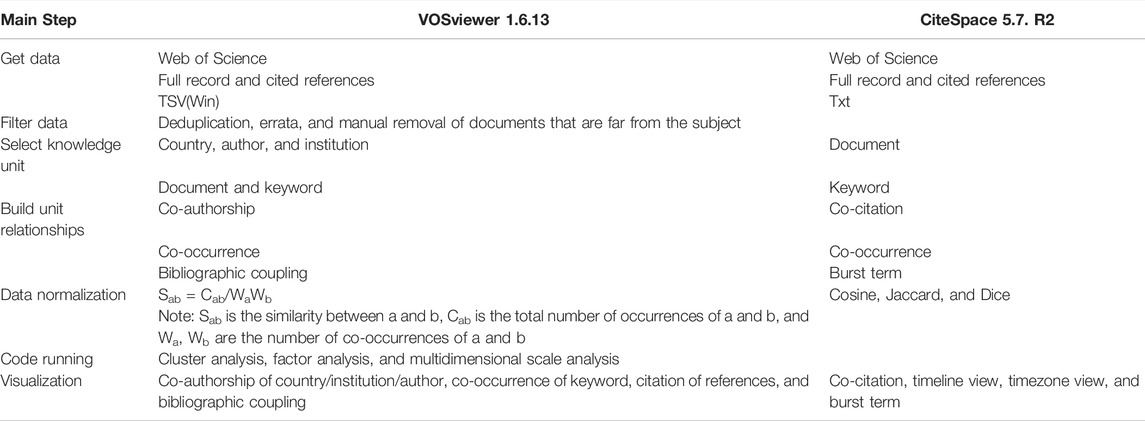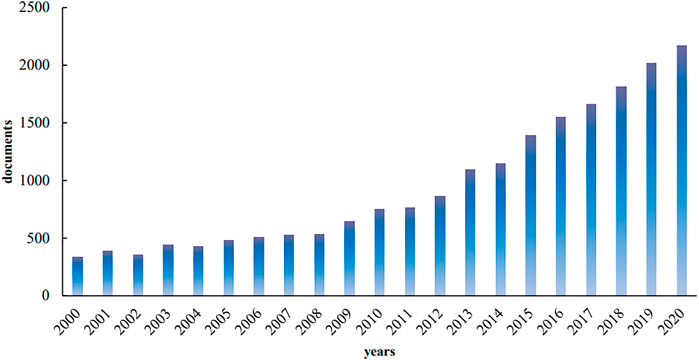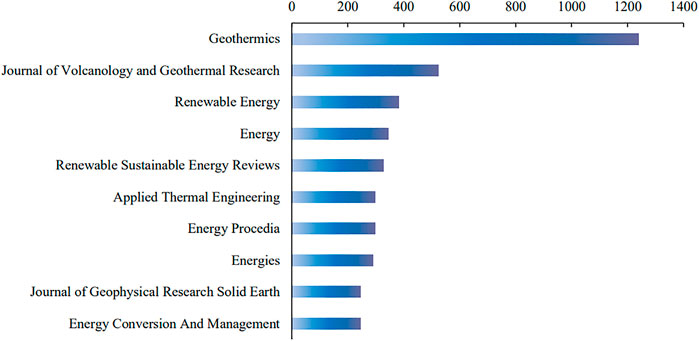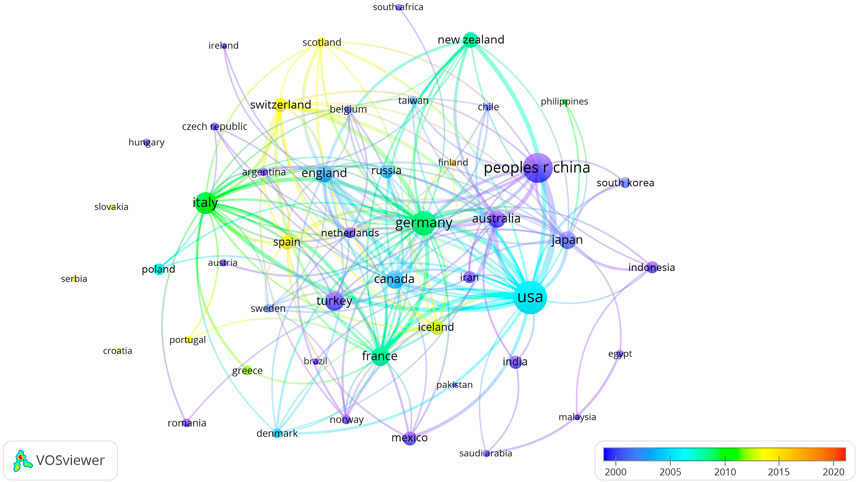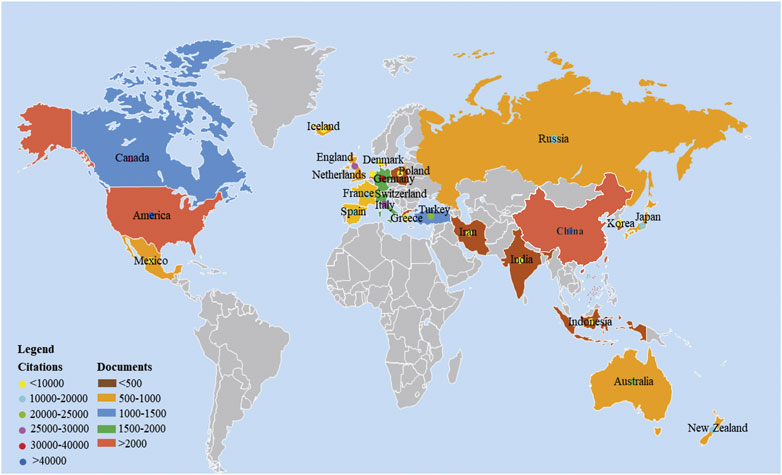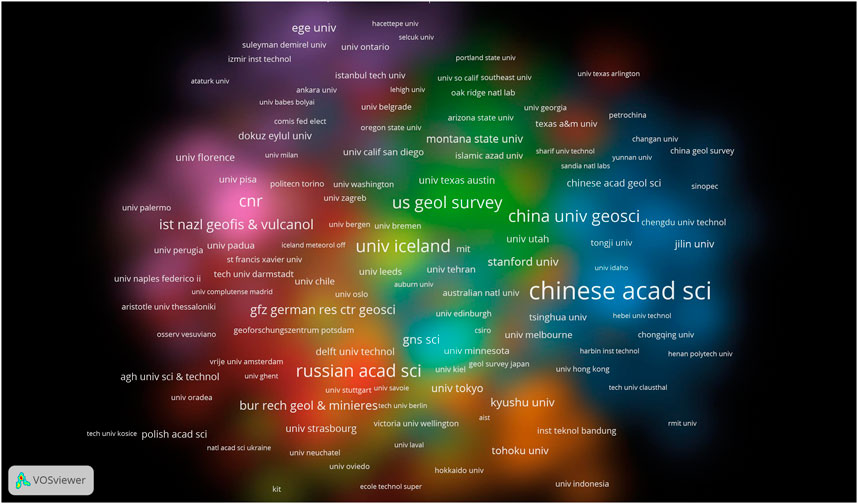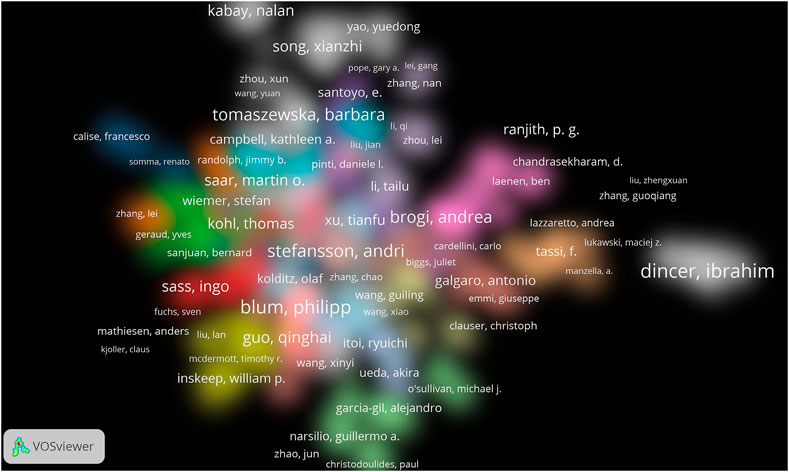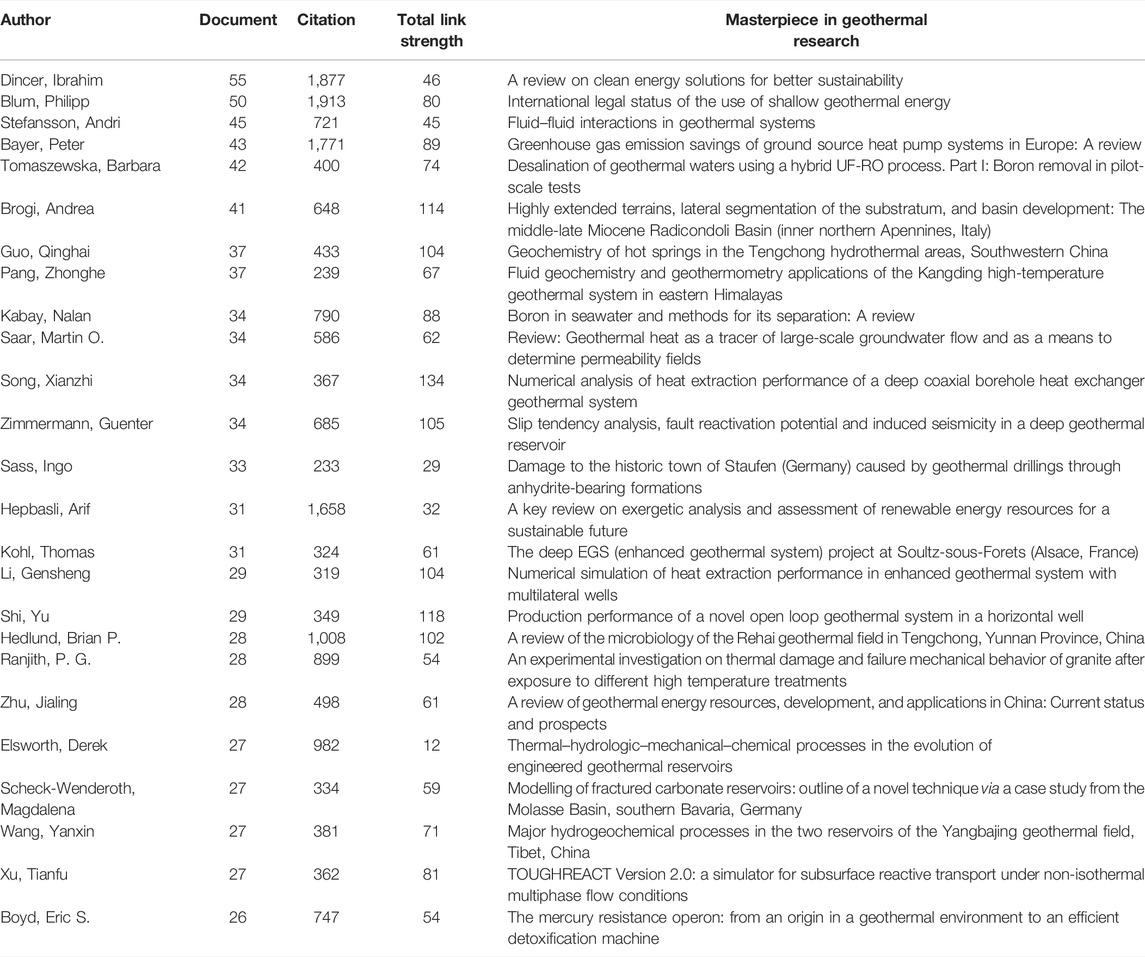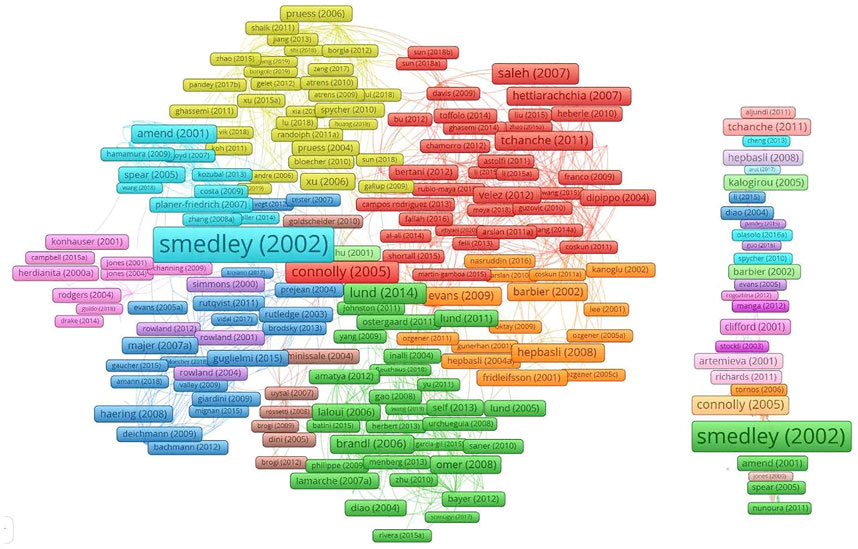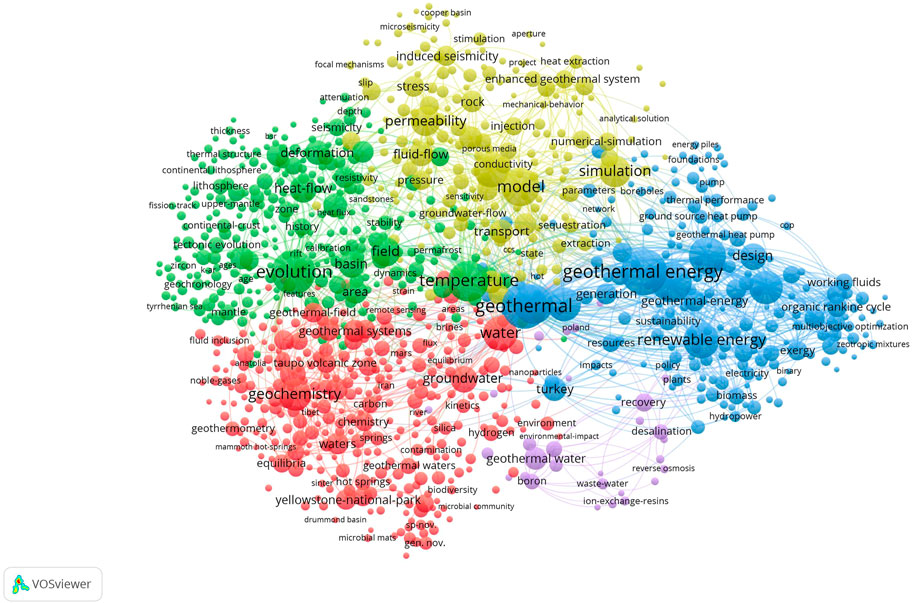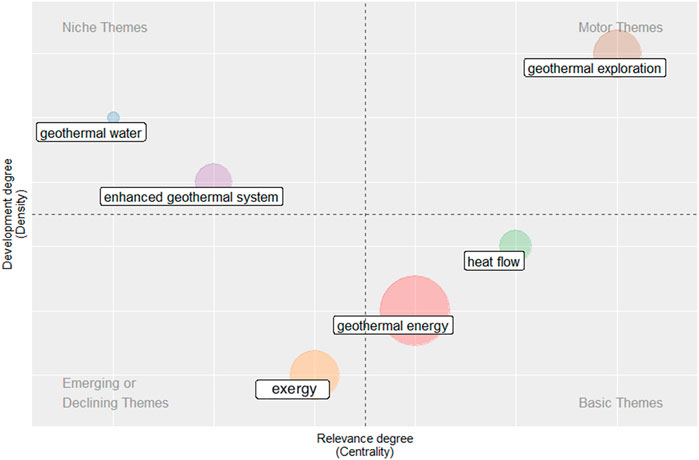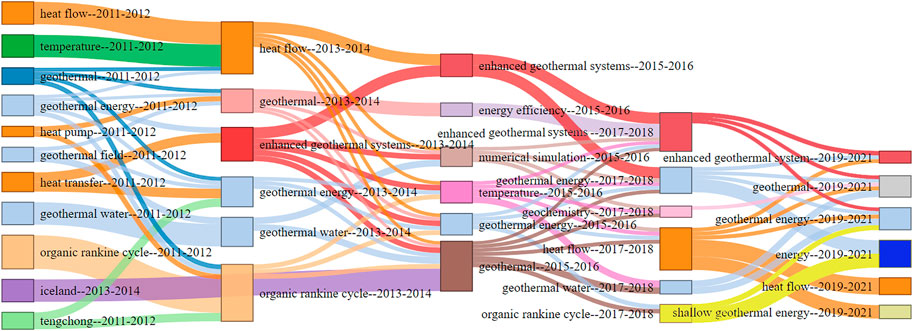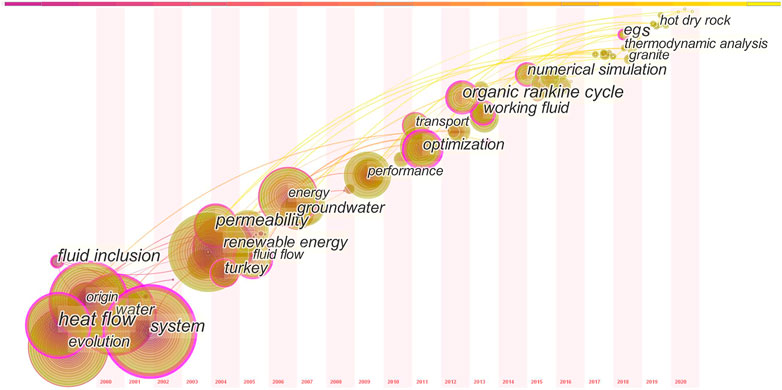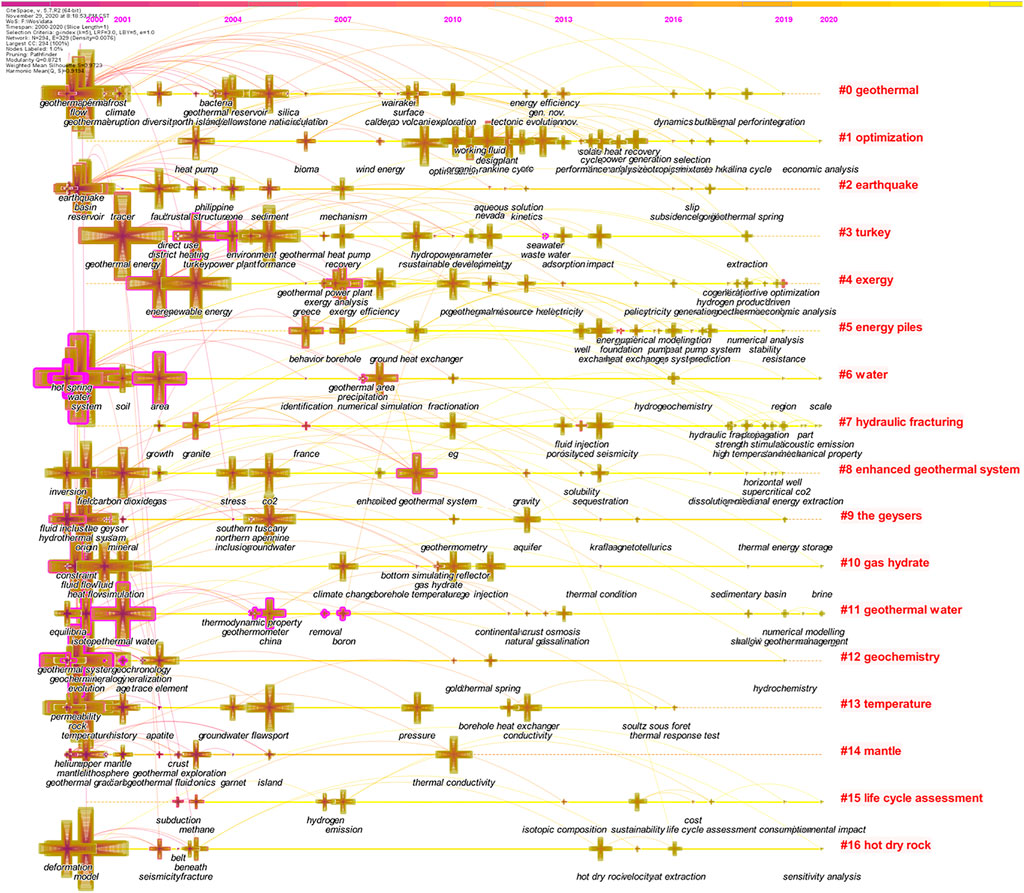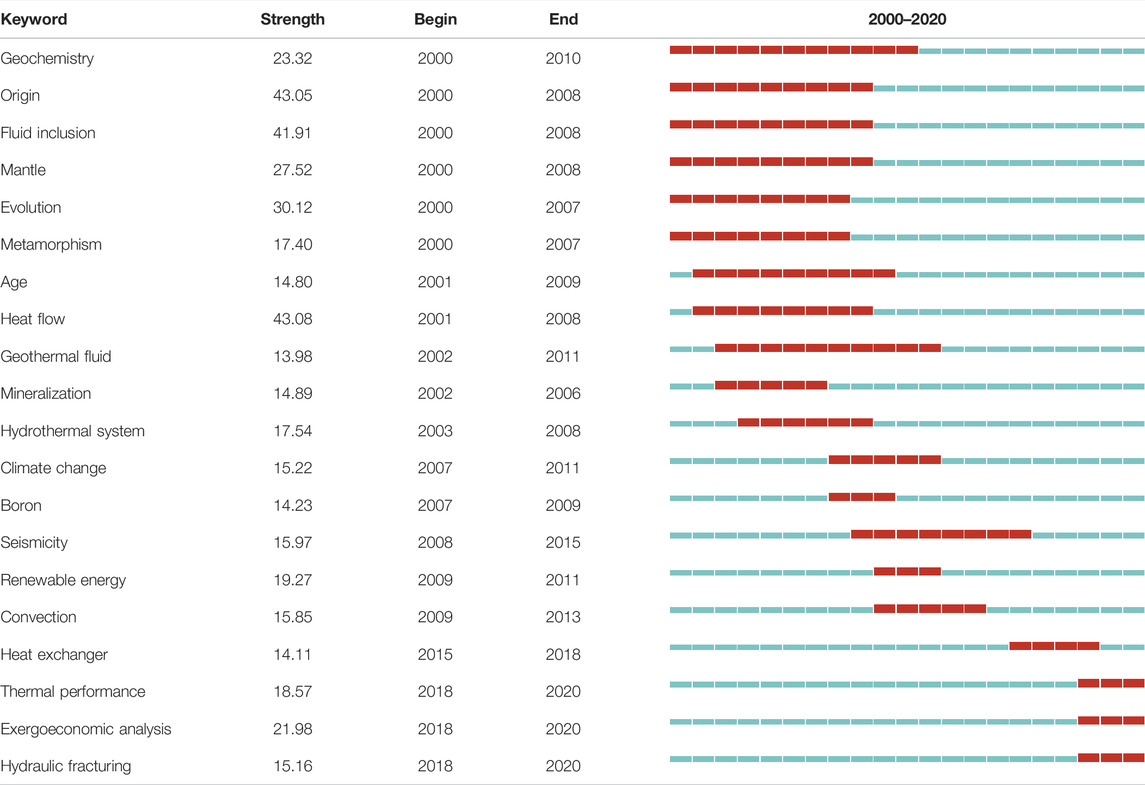- 1School of Earth Resources, China University of Geosciences, Wuhan, China
- 2Key Laboratory of Tectonics and Petroleum Resources, Ministry of Education, China University of Geosciences, Wuhan, China
Geothermal energy is considered a renewable, clean, and environmentally friendly energy source. In addition, it is efficient and relatively cost effective. Therefore, the demand for the development and utilization of geothermal resources is increasing annually. To understand the current status and developments within the context of geothermal research, quantitative and qualitative analyses were carried out by combining two visualization software applications, namely, VOSviewer and CiteSpace; this analysis also entailed the secondary development of R language. The results showed that the USA, China, and Germany are the main contributors to geothermal research. We also found that geothermal research hot spots encompass five geothermal research clusters, such as renewable energy utilization, heat flow, numerical simulation, geochemistry, and groundwater. In addition, the strategic diagram and thematic structure revealed how geothermal research has evolved over time. Finally, the timeline view and burst term highlight the possible frontiers of geothermal power generation, enhanced geothermal systems, and ecological environment protection. These insights will provide scholars and policymakers with a systematic understanding of the current research and directions for future studies.
1 Introduction
The global adjustment of energy structures is inevitable, as nations are transitioning toward being carbon neutral. Renewable energy plays a pivotal role in this adjustment. The booklet 10 Years-Progress to Action, issued by the International Renewable Energy Agency, has emphasized that each nation will have to prioritize renewable energy in policymaking. Renewable energy will become the primary power source by 2030 when the power produced by renewable energy will account for 57% of the total power (International Renewable Energy Agency, 2020). There are a wide variety of renewable energies, including solar energy, wind energy, hydro energy, biomass, and geothermal energy. The cost structure of using renewable energies is different from traditional ones, with higher costs and lower operating costs in the initial stages. With the development of technology, geothermal power generation costs will be lowered, making it more competitive (Noorollahi et al., 2019). Geothermal energy also has the merits of enormous resource potential, stable flow, convenient use, cleanliness, and sustainability (Li et al., 2015), enabling its application worldwide and facilitating energy reform.
In recent years, bibliometric analysis has become a method for the quick exploration of hot spots and frontlines in specific research fields (Thompson and Walker, 2015). This approach can be applied to make macroscopic and overview statistics of many periodicals and documents and to quantify co-authorship, co-citation similarities, main contents, and trends (Daim and Pilkington, 2018). Geothermics is considered a promising field and continues to garner more research interest. Geothermics spans multiple sub-disciplines, namely, geology (Ngansom et al., 2019; Millett et al., 2020; Šafanda et al., 2020), tectonics (Carlino, 2018; Chicco et al., 2019; Hacıoğlu et al., 2020; Tzanis et al., 2020), geophysics (Tang et al., 2017; Mazzoldi et al., 2020; Trainor-Guitton, 2020), and hydrogeology (Yurteri and Simsek, 2017; Maya et al., 2018; Tóth et al., 2020; Torresan et al., 2020). Scholars have explored and estimated the reserves of geothermal energy. The thermal mechanisms of geothermal resources, as controlled by different fractures and fissures, have been analyzed (Ullah et al., 2022). Aeromagnetic data combined with gravity inversion have been used to search for insidious hot dry rock and anomalous geothermal zones (Elbarbary et al., 2022). Using hydrochemistry, the movement of fluids through the geothermal system has been studied (Wang et al., 2022). However, research on bibliometric visualization in geothermal studies is still lacking, and the results are scattered because of the lack of system integration and correlation. Based on the Web of Science, documents consisting of geothermal research can be collected and sorted. Then, with the help of CiteSpace, VOSviewer, and R, the knowledge domain map can be drawn, including the co-authorship network, citation network, keyword co-occurrence network, theme evolution, and burst terms. Using the aforementioned approaches, the knowledge structure, co-citation relation, and dynamic evolution in geothermics can be analyzed qualitatively. Therefore, the status, hot spots, and development trends in the field can be better understood.
2 Data and Methods
2.1 Data Resource
Data were obtained from Web of Science, an extensive and comprehensive database (Powell et al., 2016), with numerous essential journals from different disciplines. To ensure the accuracy and validity of the data, they were obtained from a literature research tool in the Science Citation Index (SCI). In SCI, 19,860 studies were chosen using the theme words “geothermal and geothermal energy,” which could be applied to CiteSpace and VOSviewer. The Web of Science Core Collection (WoSCC) database was used for all the theme words, using the primary search method, customizing the year from 2000 to 2020, and excluding documents that were far from the research topic and whose author or journal title was unsound. Six thousand five hundred and fifty-eight authors from 134 countries writings were shown to be linked to the discovered literature. Sixteen document types were identified, of which articles (77.482%) were the largest, followed by proceedings articles (19.062%), reviews (5.347%), editorial material (0.729%), and meeting abstracts (0.664%). After code screening, 5,858 journal documents could make the R language run. Many documents were excluded because of the high requirements for document format.
2.2 Methods
The knowledge mapping domain is an emerging field in bibliometrics. It is an effective method for describing scientific research cooperation, exploring subject history, and analyzing research content (Shiffrin and Börner, 2004). Through citation, multidimensional scale, factor, cluster, and co-word analyses (Chen, 2004a), a deeper level of information and a more precise knowledge structure can be found; this knowledge can be used to promote scientific research management. There are various tools for mapping knowledge domains; however, conventional software has some shortcomings. For example, visualization is not intuitive in SPSS and SAS (Preacher and Hayes, 2004); SCI2 can only hold up to 10,000 data items (Börner, 2011), and Histcite can only support one data type and cannot be used for multi-database analysis (Garfield, 2009). However, VOSviewer can perform text mining and build a symbiotic network from numerous scientific documents (Eck and Waltman, 2010). CiteSpace is more credible in dynamic analysis and has the advantage of illuminating the development and frontiers of a discipline. Therefore, two types of software packages were used in the analysis (Chen, 2006). VOSviewer was applied in co-authorship, bibliographic coupling, and co-occurrence of keywords. On the other hand, CiteSpace was used in co-citation, timeline analysis, and burst terms. Although there are some differences in their interfaces and principles, their general steps (Table 1) can be summarized as follows: obtaining data, filtering data, selecting knowledge units, building unit relationships, data normalization (Chen, 2004b; Eck and Waltman, 2009), code running, and visualization.
R language was used for secondary development to further reveal the evolution of geothermal research themes. It is an integrated software application that combines statistical analysis and graphic display and can be used for data manipulation. Compared with other statistical analysis software packages, all R functions and datasets are stored in a powerful program package. The package—bibliometrix includes bibliometrics and metrological research tools. The package is used for theme evolution and strategic coordinate analysis because it helps analyze bibliometrics more comprehensively. Bibliometrix constructs the corresponding co-occurrence network and internal connections between networks through data screening, format conversion, matrix building, data deduplication, programming weighting, and attribute adjustment. Therefore, it can classify theme types and analyze their evolution to carry out more profound knowledge discoveries in geothermal research.
3 Results and Discussions
3.1 Annual Publications and Journals
Figure 1 shows the average annual number of publications on geothermal research from 2000 to 2020. From 2000 to 2007, the number of publications was relatively low, and the average annual number of publications at this stage was less than 600. From 2008 to 2012, the number of publications grew steadily, consolidating a period of stability, with an average annual growth of approximately 100. Since 2013, there has been a remarkable increase in the number of articles published in geothermal fields, with an annual increase of 243. However, the posting growth rate in 2020 decreased slightly. On the one hand, some research cannot be conducted because of the impact of COVID-19. However, many articles are still not included in the database owing to the time lag in the inclusion of articles in the Web of Science database. However, it is expected that the annual number of publications will continue to increase rapidly in the future based on the overall upward trend.
The sources were relatively scattered (Figure 2) for essays published in journals from different fields. Therefore, a clear hierarchy has yet to be established. It is easy to find from the publications that Geothermics ranks first, accounting for 6.64% (1,240), with a CiteScore of 7.0, and an h-index of 37. Two journals, namely, the Journal of Volcanology and Geothermal Research and Renewable Energy, account for 2.80% (523) and 2.05% (383) of the publications, respectively. Although the latter has a lower volume, its CiteScore is 11.2, and its h-index is 90, much higher than the former’s CiteScore of 5.1, and an h-index of 36. The journals mentioned earlier are both highly influential, and their research outputs mainly focus on geology, engineering, geophysics, geochemistry, and environmental ecology, highlighting the interdisciplinary characteristics of geothermal research.
3.2 Co-Authorship Network
Academic co-authorship is beneficial for knowledge dissemination and can promote scientific development (Lee and Bozeman, 2005). A scientific network consists of clusters that are controlled by different factors. Scholars in each cluster are regarded as nodes that can be connected through co-authorship to create a measurable and analytical academic community network (Newman, 2001). The knowledge mapping domain can enable bibliometric visualization, allowing for an analysis about the communication and cooperation of individuals in different groups (countries, institutions, and authors) and identify the number, type, organization, and evolution of sub-networks to dissect the structure of the entire network.
3.2.1 Co-Authorship of Countries
Scientific research has already entered the era of international cooperation, so the co-authorship of countries is a vital factor in promoting technological innovation and development (Gershenson, 2013). VOSviewer can create a map of the co-authorships of countries. According to the statistics (Figure 3), 148 countries participated in international co-authoring. Ninety-eight countries met the standard with a threshold of five, full counting as the method, and adjusting the maximum number of countries per document to 25. A threshold of five means, the number of publications per country must not be lower than five; otherwise, the software excludes these countries. Full counting implies that each co-authorship link has the same weight. For instance, if a country co-authors a document with 10 other countries, each of the 10 co-authorship links weighs one while the weight is 1/10, using the fractional counting method.
There were 98 nodes and 1,460 links, and the total link strength is 10,318 in Figure 3. Each node represents a different country, the size of which refers to the number of issued documents. Only the first author and corresponding author were considered when counting the number of articles per country because it is generally accepted that they have made the most significant contribution to the articles. The thickness of the links between the nodes indicates the level of cooperation and closeness between countries. Meanwhile, the colors displayed at different times on the color card correspond to those of the nodes, reflecting the average time of publishing articles in the country. Figure 4 can be drawn by exporting data from the software, ranked by the quantity and citations of documents.
The country with the most essays is the United States (3,864), followed by China (3,112), and Germany (1,851), with citations of 98,914, 42,567, and 33,421, respectively, shown in Figures 3, 4. According to the EIA, seven states in the United States have geothermal power plants with a power generation capacity of approximately 16 billion kilowatt-hours (kWh). Before 2019, the installed geothermal power generation capacity ranked first in the world. China has focused on direct utilization of geothermal resources. The cascade utilization system was completed in 2015. The use of geothermal resources at different temperatures for bathing, medical treatment, breeding, heating, and cooling has been conducted in a place with a heating power of 17,870 MW, leading the world. As of 2017, thermal power has led the world by more than 20,000 MW. The average publication year of the documents issued by Germany was 2009, as calculated by the software. Geothermal research in Germany started relatively late compared with that in the United States and China, but the exploration has dramatically improved in the past 10 years. The Bureau for the Technological Impact Assessment of the German Bundestag (TAB) believes that the rational utilization of geothermal resources can supply the basic load of the whole country. The government has also introduced relevant geothermal power price subsidy policies to promote the sustainable development of geothermal resources.
From a co-authoring perspective, the greater the number of lines between nodes, the thicker the links and greater the cooperation between countries are. Total link strength is a critical configuration for co-authoring. The country with the most extensive international cooperation is the United States, with a total link strength of 2,395, followed by Germany, with a total link strength of 1,579, and the third country is the United Kingdom, with 1,129. From Figure 3, it can be seen that the United States–German, United States–United Kingdom, and United States–China have frequent cooperation. Simultaneously, countries such as South Africa, Malaysia, Serbia, Hungary, and the Philippines are shown as single nodes, meaning that they are less involved in international cooperation. As the situation continues, the latest technologies will spread in a small area, causing polarization. However, strengthening cooperation among countries can promote the geothermal industry through international academic conferences and projects. For instance, the latest theories from different studies can be integrated. Cooperation also allows countries to share unique technologies, including hot dry rock reservoir stimulation, hydraulic fracturing, ground source heat pumps, and geothermal power generation. Cooperation in technological development is beneficial for innovative breakthroughs that can be applied to geothermal exploration and production.
3.2.2 Co-Authorship of Institutions
A co-authorship map of institutions can be drawn using the same principles as national co-authoring. Nine thousand and fifty-three institutions participated in co-authoring, and 1,260 of them met the requirements mentioned before.
There are 1,260 nodes and 11,973 links, and the total link strength is 18,808 in Figure 5. The node size reflects the number of documents issued by an institution. The most noticeable feature of the density view is that the node’s connection is weak, and the degree of co-authorship is shown by different brightness, which means the brightest areas indicate organizations with a large amount of cooperation and strong link strength. Institutions in the same cluster have the same color. This reveals that scientific research clusters can break the boundaries of disciplines, regions, and industries to form groups of academic significance, depending on the nature and innovation of the industry to be served. Figure 5 shows that the institutions with outstanding publication volumes are the Chinese Academy of Sciences (519), Russian Academy of Sciences (299), and University of Iceland (297). The most cited institutions were the United States Geological Survey (9,674), the Chinese Academy of Sciences (7,567), and the University of California, Berkeley (6,178). The institutions with the highest total link strengths are the Chinese Academy of Sciences (661), the United States Geological Survey (430), and the Italian National Research Council (419). The results showed that the Chinese Academy of Sciences has outstanding performance in terms of the number of publications, citations, and total link strength. It actively conducts geothermal research, and pays attention to scientific research communication. Its main partners are the University of California, Berkeley, the China University of Geosciences, and the China University of Petroleum. It can be seen that many universities have also been involved, except research institutes, and a research system has taken shape.
3.2.3 Co-Authorship Analysis
The author is the smallest unit in the co-authorship network, and the major academic groups and leading figures in the geothermal field can be identified through visualization analysis. Figure 6 shows a density view that takes authors as nodes, and the parameter settings of the figure are consistent with the density view of the co-authorship of institutions. According to the data screening results, 1,763 authors met the criteria, out of 47,575 authors. The number of authors involved in the study was relatively large; however, the clustering division in the figure was apparent, and even clear boundaries could be observed. These results indicate that the authors were more inclined to communicate in small groups. The academic links among teams are weak and not conducive to sharing the latest scientific research results or making breakthroughs. Dincer Ibrahim and Blum Philipp are the most published and cited authors, whereas, Song Xianzhi takes the lead in the total link strength.
Based on the number of published documents, the most cited articles of the top 25 authors on the Web of Science were counted to explore the main research directions of different authors (Table 2). Dincer Ibrahim, who specializes in engineering and mechanical research, has extensively explored the impact of exergy on the environment and sustainable energy development. As the adequate energy in the working medium of a thermal system, exergy is determined by both the system and the environment, and the exergy equilibrium analysis principle lays the foundation for thermodynamic analysis (Dincer, 2001; Dincer and Rosen, 2012). Philipp Blum and Professor Bayer Peter cooperated closely in engineering geology and groundwater simulation research. They focused on the development and utilization of shallow geothermal energy and believed that ground source heat pumps for cooling and heating are highly efficient, energy saving, and have low operating costs. This can reduce greenhouse gas emissions and protect the environment (Blum et al., 2010; Bayer et al., 2012; Hähnlein et al., 2013). In addition, to better reveal the migration laws and formation mechanisms of groundwater in geothermal systems, many scholars, such as Guo Qinghai, Saar, Martin O., Wang Yanxin, and Xu Tianfu, focused on geothermal hydrogeology research. They are devoted to exploring the geochemical characteristics of geothermal fluids, isotopic tracers, and the coupling of groundwater seepage fields (Guo et al., 2007; Saar, 2011; Xu et al., 2011; Guo and Wang, 2012).
3.3 Co-Citation Network
Co-citation means that two articles are simultaneously cited by a third article. Similar to bibliographic coupling, it can reflect the degree of connection and structural relationships between documents. Bibliographic coupling reflects the relationship between two cited references, whose coupling strength remains unchanged and is a static model. In comparison, co-citation reflects the relationship between two cited references, the strength of which is determined by other references and is a dynamic superiority model (Egghe and Rousseau, 2002; Garfield et al., 2005).
The software CiteSpace can be used to map the knowledge domain regarding the co-citation of documents (Figure 7). In Figure 7, nodes represent different co-cited documents. The larger the node, the more co-cited the documents are. Based on the co-citation relationship and the number of studies, the literature can be divided into eight clusters. The Q value represents the module value. Each subdomain in the co-cited cluster was defined as significant when it was greater than 0.3. The S value represents the contour value. In this figure, Q (0.9224) satisfies the conditions and S (0.8645) reflects the high homogeneity of research clustering. The loglikelihood ratio (LLR ratio) algorithm was used to extract labels from literature titles, keywords, and abstracts. They were then numbered. The smaller the number, the larger the clustering scale is. The clustering color reflects the average year of the cited references. An earlier average year has a deeper color. The large clusters shown in the figure are #0 Kalina cycle, #1 renewable energy, and #2 stromatolites, in which geothermal as renewable energy has attracted widespread attention. Stromatolites are usually found in dolomite and limestone, which are suitable thermal reservoirs that are relatively easy to exploit. The Kalina cycle is an effective method for recycling low-grade heat. An ammonia–water mixture is used as the working medium. The efficacy of this medium is based on the organic Rankine cycle to optimize the thermal economy performance and cycle efficiency. The cycle ensures better heat transfer matching relationship with the heat source and cold source on the whole (Zhang et al., 2012; Rostamzadeh et al., 2019; Zhou et al., 2020). The lighter themes were (#4 induced earthquake) and (#5 mechanical properties). In 2017, a MW5.4 earthquake occurred in Pohang, South Korea. According to two complementary studies based on seismic, geodesy, and geological data from the June 2018 issue of Science, the earthquake may have been triggered by injecting high-pressure water into the stratum at depths of more than 4,300 m, providing a “lubricant” for an unknown fault in the rock, shifting static stress, and causing fault slip (Grigoli et al., 2018; Kim et al., 2018). Since then, it has become a hot topic to discuss whether exploiting hot dry rocks will induce earthquakes. These factors are complicated, and specific conclusions remain to be verified. In addition, research on the mechanical properties of rocks and materials has gradually increased, which is significant for improving the stability of artificial reservoirs (Wyering et al., 2014; Li et al., 2020).
3.4 Co-Occurrence Network of Keywords
Keywords can summarize the topics and content of the literature. Many studies are based on the belief that the frequency of keywords can indicate the concentration and extent of research results in this field, which can be used to judge research hot spots (Chen, 2006; Eck and Waltman, 2009; Eck and Waltman, 2010; Jia et al., 2020). The principle of cluster analysis is based on the use of similarity to classify messy information. For instance, cluster analysis based on keyword frequency statistics can indicate closely related topics (Garrigos-Simon et al., 2019; Yang et al., 2019). In VOSviewer, the node type was set as a keyword and the network relationship as co-occurrence. The color shows different clusters, and the size of the nodes represents the frequency of keywords; the larger the node, the higher is the frequency. Together with the font size, it determines the weight of the node. When both are underlined, nodes are more vital. The lines between nodes indicate the relevance of nodes. The thicker the lines, the closer is the connection.
In Figure 8, the knowledge mapping domains can be obtained with the search subject word “geothermal” and “geothermal energy.” There were 4,846 of the 47,036 keywords satisfying the requirements under the threshold value of five. Owing to the significant deviation between some keywords and overall clustering, the software adopted automatic screening for an obvious result. After screening, there were 444 nodes, eight clusters, and 12,666 connections. In addition, the total connection strength was 25,021 (Figure 8). It can be concluded from the comprehensive heat and intensity that the more important nodes in the figure include “geothermal energy,” “evolution,” “temperature,” “system,” and “model,” and their co-occurrence frequencies are 1,164, 1,050, 899, 827, and 791 times, respectively. The connection intensities were 7,181, 8,852, 7,198, 6,543, and 5,962, respectively (Figure 8). This indicates that the formation and evolution of the geothermal system, estimation of heat storage temperature, and modeling in geothermal energy exploration are current hot spots.
Clusters with different colors indicate that the main ideas of current geothermal research can be summarized into five aspects (Figure 8).
Cluster 1 (green): This was carried out around the headword “evolution” from the perspective of geophysics and geology (Figure 8). Geothermal energy is stored in the Earth’s interior, and its formation and evolution are relatively complicated. To fully exploit the advantages of hierarchical utilization, according to the temperature of the thermal reservoir, geothermal energy can be divided into high temperature, medium temperature, medium-low temperature, and other types of resources. During geothermal resource exploration, measurement of geophysical properties is essential. It can reveal key parameters such as geothermal gradient, terrestrial heat flow value, reservoir temperature, and specific heat, illuminating the formation lithology, geological structure, and relationship of the geothermal system (Barbier, 2002; Zuo et al., 2013; Gasperikova and Cumming, 2020) by using seismic prospecting, electrical methods, magnetism, gravity measurement, remote sensing, and other indirect methods.
Cluster 2 (red) and Cluster 3 (purple): Cluster 2 focuses on geochemical methods, whose central word is “geochemistry.” Cluster 3 focuses on hydrogeology, with the core item of “geothermal water” (Figure 8). Both concentrate on geothermal fluids, the most common of which is groundwater. Geochemical methods are recognized as one of the most economical and practical geothermal research techniques. Geothermal fields can be effectively searched based on the abnormal values of some elements in soil (Kaasalainen et al., 2015), such as mercury (Pastrana-Corral et al., 2016), arsenic (Ballantyne and Moore, 1988), and antimony (Wilson et al., 2012), by testing and analyzing the characteristics of various major and trace elements and isotopes in geothermal water. In addition, the chemical composition of natural hot springs and boiling springs can be successfully determined (Guo et al., 2017); this knowledge can then be combined with our understanding hydrogeology and used to infer the physiochemical reactions of ions during fluid migration (Wang et al., 2013).
Cluster 4 (blue): Geothermal energy is mainly analyzed from the perspective of economics and engineering with the headwords “geothermal energy” and “renewable energy” (Figure 8). Within the context of geothermal energy, costs also need to be considered when its further development and utilization is concerned. Under the guidance of the principles of economics and the exergy equilibrium equation from thermoeconomics, the relationship between the variables can be determined by selecting the constraint conditions and decision variables. Mathematical methods can then describe the objective function and constraint equation (Valero et al., 1986; Valero et al., 1993; Zaleta-Aguilar et al., 2007). Thus, feasible solutions have been proposed, such as optimizing the best parameters of the ground source heat pump based on pure heat transfer thermodynamics (Lai, 2013), improving and designing well configurations based on changes in heat flux, heat load, and annual mean temperature (Retkowski and Thöming, 2014); overall, reducing the cost of generating electricity by opting for power generation cycle patterns (Coskun et al., 2014; Fallah et al., 2018) and promoting the economic competitiveness of geothermal power stations by adjusting the pressure levels for cycles (Leveni et al., 2019; Talluri et al., 2019).
Cluster 5 (yellow): It takes “model” as the core item and elaborates the application of numerical simulation in geothermal geological modeling (Figure 8). Numerical simulations have been widely used in groundwater, oil, and gas reservoir modeling. However, geothermal resources are also abundant. The geological formation process is complex, including chemical dissolution and precipitation, ion reaction, and rock creep deformation, when the stress in the rock changes under high temperature and pressure. Therefore, the numerical simulation of geothermal reservoirs is still in the exploratory stages, owing to the highly complicated transmission coupling between energy and mass (O’Sullivan et al., 2001), involving multiple coupling effects of the temperature, seepage, stress, and chemical fields. The mathematical model can be simplified to a certain extent using FEFLOW, Moodflow, COMSOL, Eclipse, OGS, and other software. However, the simulation results can be more accurate when the acquisition of geological information can be maximized (Franco and Vaccaro, 2014; Aliyu and Archer, 2021), for example, boundary conditions, source and sink terms (meteoric water supply, water head difference, etc.), fracture distribution and types, reservoir properties (formation thickness, reservoir porosity and permeability, density, thermal conductivity, etc.), and fluid properties (fluid properties, flow rate, density, viscosity coefficient, etc.). This approach is meant to prevent geological disasters and ensure the sustainable development of geothermal resources.
It is evident that the five clusters focus on different aspects but are also related. Geological theory and geophysical detection (green clusters) are essential exploration methods for identifying favorable zones. Geochemistry and hydrogeology (red and purple clusters) can effectively evaluate geothermal fields because they can deduce the evolution of geothermal systems based on the current fluid composition. Engineering design (blue cluster) and numerical simulation (yellow cluster) are advanced optimizations for geothermal development, as they can reduce drilling costs for shallow geothermal energy and hot dry rock. In addition, different clusters can provide complementary evidence. For example, high heat flow values and fluid isotope shifts often indicate anomalous geothermal areas. Seismic wave and rock mechanics data are integral to establishing 3D geological and drilling models. The common goal of all five clusters is to achieve geothermal energy exploration and development.
3.5 Frontal Analysis
The key literature often shows certain patterns over time, revealing the evolutionary trajectories of relevant themes and even yielding the main dynamics of a field (Aria and Cuccurullo, 2018; Rodríguez-Soler et al., 2020; Ghosh and Prasad, 2021). The timeline view, timezone view, and burst term can be obtained by setting the threshold to one and inserting the time layout through cluster analysis on keyword co-occurrence in CiteSpace. In addition, 5,858 articles from the database were imported into the R language to plot the strategic diagram and thematic evolution structure by loading the function package Bibliometrix (Aria and Cuccurullo, 2018) to program the downloaded dataset. They both reflected the changes in themes and frontier content in geothermal research.
3.5.1 Strategic Coordinate Analysis
The strategic diagram of R language (Figure 9) divides the theme types through different quadrants. The “vertical axis” represents the weight (centrality) of the theme and the “horizontal axis” represents the development degree (density) of the theme. The research themes were divided into four groups (Figure 9): a) motor themes (first quadrant): high concentration and high density, reflecting essential, and well-developed themes; b) niche themes (second quadrant): high concentration and low density, reflecting important but not well-developed themes; c) emerging or declining themes (third quadrant): low centrality and low density, reflecting the themes that are about to disappear, or maybe a frontier theme that will emerge in the future; and d) basic themes (fourth quadrant): low centrality and high density, reflecting the themes that have been well-developed with little prospect in the future and usually refers to the basic concept, such as a search term. As shown in Figure 9, the theme of the first quadrant is “geothermal exploration,” which indicates that the exploration and development of geothermal resources has received close attention and will continue to be carried out (Zaher et al., 2018; Ars et al., 2019; Thomas et al., 2019; Guglielmetti and Moscariello, 2021). The second quadrant is “geothermal water” and “enhanced geothermal system” enhanced geothermal systems. Both are widely distributed and have great resource potential and good application prospects (Agemar et al., 2014; Ma et al., 2017; Yurteri and Simsek, 2017; Lu, 2018; Catalan et al., 2019; Torresan et al., 2020; Tóth et al., 2020). However, they may not be well-developed due to scientific and technological limitations. The theme of the third quadrant is “exergy.” Theoretical research on exergy calculation and energy-level analysis has developed rapidly since the establishment of the first and second laws of thermodynamics. Exergy has been widely used in energy-saving projects (Zaleta-Aguilar et al., 2007; Bina et al., 2018; Yilmaz and Koyuncu, 2021), so it will not be very innovative in the future. The fourth quadrant is themed as “geothermal energy” and “heat flow,” which may be the first to be studied and developed, showing it to be a foundational theme of geothermal research.
3.5.2 Theme Evolution
The theme model generates differentiation on a time scale and evolves into multiple related topic paths. Each theme is one-to-one, corresponding to the text in the literature (Furstenau et al., 2021). Therefore, R can be used to establish a matrix related to the topic and time. Based on the matrix calculation, the thematic evolution function of the bibliometrix function package was used to obtain the thematic evolution structure by dividing the 10-years data into four time periods, setting the time nodes as 2012, 2014, 2016, and 2018, and five as the minimum occurrence frequency (Figure 10). The timezone view (Figure 11) is drawn using the co-occurrence function of CiteSpace, where nodes represent subject words, the purple aperture outside the nodes represents centrality, and the lines represent the connections between subject words (Liu et al., 2020). It is worth noting that the larger the node, the higher is the occurrence frequency of the subject word. In addition, the more pronounced the purple aperture and the more connections, the more influential is the node. The position of each node in the figure depends on the year in which the corresponding dataset first appeared. Although the subject term will still appear in later years, it will only accumulate at the node where it first appeared.
Based on Figure 10, the themes can be divided into two categories. The first category includes recurring themes, such as “geothermal,” “geothermal energy,” “geothermal water,” “organic Rankine cycle,” and “heat flow” (Figure 10). Since the appearance of this theme in 2010, it has been repeated every period and has been the focus for a long time. The second category is the newly developed theme, such as “heat pump,” “heat transfer,” “energy efficiency,” “enhanced geothermal system,” and “shallow geothermal energy” (Figure 10). However, the emergence times of these themes were not fixed. “Heat pump,” “heat transfer,” and “energy efficiency” only repeat for a period, indicating that they were hot spots in a short period but overlapped with other branches and were merged with the evolution of geothermal energy. “Enhanced geothermal system” has spread in various paths since its appearance in 2013 (Figure 10). This indicates the rapid development of hot dry rocks. Among renewable energy sources, only an enhanced geothermal system (EGS) can provide an uninterrupted power supply, which is not affected by natural conditions such as season, climate, and illumination, with many prospects (Lu, 2018). “Shallow geothermal energy” appeared in 2019 (Figure 10) because the development and utilization of it involve global assignments such as urban energy structure, environmental protection, and improvement of people’s quality of life, and its scale and development speed are growing promptly (Garcia-Gil et al., 2020; Tsagarakis, 2020; Xu et al., 2020).
In Figure 11, it can be seen that: a) from 2000 to 2004, the nodes with high centrality and frequency were “heat flow,” “system,” and “ permeability.” b) From 2005 to 2010, the nodes with high centrality and frequency were “groundwater,” “fluid flow,” and “performance.” c) From 2011 to 2020, the nodes with high centrality and frequency are “optimization,” “organic Rankie cycle,” and “numerical simulation.” Figures 10, 11 jointly reveal that geothermal research started with concept establishment, geophysical exploration, and geochemical exploration in the early stages (Studt and Thompson, 1969; Ólafur and Saemundsson, 1993; Tanaka, 2004) and then focused on the utilization and improvement of the thermal performance of hydrothermal geothermal resources (Qin et al., 2005; Han et al., 2010; Aneke et al., 2011; Saar, 2011). In recent years, mathematical statistics and big data analytics have been combined to generate numerical simulations and system optimizations of geothermal resources to attain the use and development of hot dry rock resources (Zeng et al., 2017; Song et al., 2018; Zhou et al., 2019; Liu et al., 2021; Aliyu and Archer, 2021; Zinsalo et al., 2021) and promote the establishment of geothermal power stations.
3.5.3 Frontier Prediction
The timeline view (Figure 12) takes the publication time of the literature as the horizontal axis, the clustering status of different keywords as the vertical axis, and documents with the same clustering label are located on the same horizontal line. According to the number of documents in each cluster and the centrality of the keywords, the first three clusters were “#6 water,” “#11 geothermal water,” and “#12 geochemistry,” with excellent keyword frequency and purple aperture thickness (Figure 12). Judging from the number, length, and density of the links, this research trend will not weaken. As early as 1983, Arnorsson et al. (1983) adopted geochemical means to correct the chalcedony and sodium–potassium geothermometers in the Iceland’s process of geothermal exploration and proposed a new geochemical geothermometer. In 1993, the systematic process of geothermal fluid exploration and evaluation, including analysis of groundwater types, determination of fluid components, calculation of water and rock dissolution equilibrium processes, and analysis of geothermal steam conductivity, were summarized (Nicholson, 1993). In 2010, Welch et al. (2010)found that arsenic tended to be enriched in alkaline groundwater with a sufficient magma heat source, so favorable geothermal areas could be found through arsenic abnormity. In recent years, groundwater chemistry has been actively studied (Ma et al., 2017; Gan et al., 2019; Gao et al., 2019; Shah et al., 2020; Lautze et al., 2020; Haklidir et al., 2021). Furthermore, unlike the clustering of most nodes with high centrality, which only appears in the early stage, the second half of the time axis of “#1 optimization,” “#7 hydraulic,” and “#8 enhanced geothermal system” also has many breakouts of small nodes, which indicates that the study is of high significance, continuity, and innovation. In particular, they can also be closely associated with several clusters such as “#2 earthquake,” “#4 exergy,” “#9 the geysers,” and “#13 temperature” (Figure 12). To a certain degree, numerical simulation is an excellent way to evaluate the quantity and grade of hot dry rock (Feng et al., 2012), the fracture formation process and the hydraulic fracturing mode are simulated, and the changes in the long-term parameters are predicted (Zhang et al., 2013; Gong et al., 2020) to optimize the maintenance system. However, whether an EGS induces earthquakes or causes microseismic activity remains a controversial issue that has caused delays and cancellations of several EGS projects worldwide (Majer et al., 2007). Some scholars believe that underground stress disturbances may change the original stress state of a fault and activate it to induce an earthquake (Grigoli et al., 2018; Kim et al., 2018; Trutnevyte and Azevedo, 2018). On the other hand, others believe that microseismic activity has almost no adverse physical impact on construction operations, and that major earthquake events can be predicted by traffic light protocols (TLP) or statistical models such as probabilistic seismic hazard analysis (PSHA) (Mignan et al., 2015; Hofmann et al., 2018; Atkinson et al., 2020).
The Burst term refers to keywords cited more than the average value of a period, which can indicate the frontier of a research field (Yang et al., 2020; Azam et al., 2021). In Table 3, sorted by the years of emergence, the delicate blue grid from left to right represents the years from 2000 to 2020, and the bold red grid represents the years of the emergence of this keyword. Therefore, the change in the knowledge structure of geothermal research is clearly demonstrated. The keyword with the longest burst time is “geochemistry,” which first appeared in 2000. Although the burst ended in 2007, it has always been an economical and effective means for geothermal exploration and development. Moreover, the keywords with vigorous emergent intensity are “heat flow,” “origin,” and “fluid inclusion,” and for terrestrial heat flow is the most direct surface manifestation of geothermal energy. The geothermal evolution process can be inferred from the excellent correlation between fluid inclusions and ancient Earth to trace the source of the geothermal system (Vivo et al., 1989; Moore et al., 2001). “Thermal performance,” “exergoeconomic analysis,” and “hydraulic fracturing” are the latest burst term (Table 3). For instance, the following aspects are attracting a large number of researchers to study: 1) In the development of shallow geothermal energy and hydrothermal geothermal resources, how to improve the thermodynamic performance of the ground source heat pump (Hou et al., 2020; Ozturk et al., 2020; Pishkariahmadabad et al., 2021; Ural et al., 2021). 2) How to prolong the service life of deep borehole heat exchangers, using the exergoeconomic method and thermodynamic modeling; in order to optimize the benefits of geothermal power plants (Fiaschi et al., 2014; Pambudi et al., 2018; Martínez et al., 2020; Yan et al., 2021). 3) Under the conditions of high pressure and high temperature, how to overcome the difficulty of hydraulic fracturing in hard and tight rock (Abuaisha et al., 2016; Yoo et al., 2021; Zhou et al., 2021), accelerating the use and development of hot dry rock resources.
Based on the three sub-sections mentioned previously, it is evident that dynamic frontiers occur in late and crucial nodes. In addition, there are still shortcomings in global geothermal research: 1) the theory and mechanism of geothermal genesis is relatively vague. The current evaluation methods for geothermal resources are relatively simple. 2) The sensitivity of geophysical and geochemical detection instruments is low. The efficiency of the drilling equipment has not been effectively improved. 3) Geothermal energy policy is insufficient. Supervision and regulations are not sufficiently complete.
Further studies should focus on genesis theory and evaluation methods for deep geothermal resources. In the future, scholars need to pay more attention to the theories of ductile flow in the lower crust, structural heat accumulation, and oceanographic geothermal. Technicians should strengthen the research and development of the following aspects, including geothermal reservoir detection equipment, heat transfer materials, and drilling technology under high temperature and high pressure. In addition, the government should establish a unified standard for geothermal resource development and utilization. Therefore, it is necessary to promulgate relevant management policies and regulations. The environmental problems caused by recharge, CO2 fracturing, and earthquakes induced by the development of geothermal resources cannot be neglected.
4 Conclusion
Through quantitative and qualitative analyses of the status and development dynamics of geothermal research, the following conclusions can be drawn:
(1) The research system has been basically formed, thanks to the outstanding contributions of geoscience institutes in the United States, China, Germany, etc.
(2) Geothermal research initially concentrated on basic theories such as terrestrial heat flow, then gradually shifted to geothermal reservoir and geothermal power generation, and finally focused on hot dry rocks.
(3) The current hot spots of geothermal research can be classified into five clusters: “clean and renewable energy utilization,” “development of medium and high-temperature geothermal energy,” “genesis and evolution of geothermal system,” “groundwater,” and “geochemistry.”
(4) The following aspects will be the frontier of geothermal research: improving the structure of the ground source heat pump to efficiently develop shallow geothermal energy, use of the enhanced geothermal system to exploit hot dry rock resources, how to use numerical simulation to achieve multi-field coupling, and how to use geothermal energy generation to achieve energy conservation and emission reduction.
In terms of the global energy strategy, geothermal energy development also needs to take full account of national policies. Scholars, technicians, and the government should make efforts to address the challenges and frontiers to promote sustainable geothermal energy development. International cooperation promotes geothermal exploration in developing countries. Legislation first lays a foundation for the management of geothermal energy. Policy incentives then promote the large-scale development and utilization of geothermal energy. The goals of carbon neutrality, energy savings, and emission reduction then become feasible.
This study has some limitations. The screening of terms requires repetitive manual work, and the magnitude of the terms is still not uniform through the clustering algorithm. To obtain more accurate results, visualization software needs to be optimized by secondary development in the future.
Data Availability Statement
The original contributions presented in the study are included in the article/Supplementary Material; further inquiries can be directed to the corresponding author.
Author Contributions
XW: data collection, data treating, plotting, and writing. HZ: data collection, data treating, and plotting. CS: revising and guiding.
Conflict of Interest
The authors declare that the research was conducted in the absence of any commercial or financial relationships that could be construed as a potential conflict of interest.
Publisher’s Note
All claims expressed in this article are solely those of the authors and do not necessarily represent those of their affiliated organizations, or those of the publisher, the editors, and the reviewers. Any product that may be evaluated in this article, or claim that may be made by its manufacturer, is not guaranteed or endorsed by the publisher.
References
Abuaisha, M., Loret, B., and Eaton, D. (2016). Enhanced Geothermal Systems (EGS): Hydraulic Fracturing in a Thermo–Poroelastic Framework. J. Petrol. Sci. Eng. 146, 1179–1191. doi:10.1016/j.petrol.2016.07.027
Agemar, T., Weber, J., and Schulz, R. (2014). Deep Geothermal Energy Production in Germany. Energies 7, 4397–4416. doi:10.3390/en7074397
Aliyu, M. D., and Archer, R. A. (2021). Numerical Simulation of Multifracture HDR Geothermal Reservoirs. Renew. Energy 164, 541–555. doi:10.1016/j.renene.2020.09.085
Aneke, M., Agnew, B., and Underwood, C. (2011). Performance Analysis of the Chena Binary Geothermal Power Plant. Appl. Therm. Eng. 31, 1825–1832. doi:10.1016/j.applthermaleng.2011.02.028
Aria, M., and Cuccurullo, C. (2018). Bibliometrix: An R-Tool for Comprehensive Science Mapping Analysis. J. Inf. 11, 959–975. doi:10.1016/j.joi.2017.08.007
Arnórsson, S., Gunnlaugsson, E., and Svavarsson, H. (1983). The Chemistry of Geothermal Waters in Iceland. III. Chemical Geothermometry in Geothermal Investigations. Geochimica Et Cosmochimica Acta 47, 567–577. doi:10.1016/0016-7037(83)90278-8
Ars, J.-M., Tarits, P., Hautot, S., Bellanger, M., Coutant, O., and Maia, M. (2019). Joint Inversion of Gravity and Surface Wave Data Constrained by Magnetotelluric: Application to Deep Geothermal Exploration of Crustal Fault Zone in Felsic Basement. Geothermics 80, 56–68. doi:10.1016/j.geothermics.2019.02.006
Atkinson, G. M., Eaton, D. W., and Igonin, N. (2020). Developments in Understanding Seismicity Triggered by Hydraulic Fracturing. Nat. Rev. Earth Environ. 1, 264–277. doi:10.1038/s43017-020-0049-7
Azam, A., Ahmed, A., Kamran, M. S., Hai, L., Zhang, Z., and Ali, A. (2021). Knowledge Structuring for Enhancing Mechanical Energy Harvesting (MEH): An In-Depth Review from 2000 to 2020 Using CiteSpace. Renew. Sustain. Energy Rev. 150, 111460. doi:10.1016/j.rser.2021.111460
Ballantyne, J. M., and Moore, J. N. (1988). Arsenic Geochemistry in Geothermal Systems. Geochim. Cosmochim. Acta 52, 475–483. doi:10.1016/0016-7037(88)90102-0
Barbier, E. (2002). Geothermal Energy Technology and Current Status: an Overview. Renew. Sustain. Energy Rev. 6, 3–65. doi:10.1016/S1364-0321(02)00002-3
Bayer, P., Saner, D., Bolay, S., Rybach, L., and Blum, P. (2012). Greenhouse Gas Emission Savings of Ground Source Heat Pump Systems in Europe: A Review. Renew. Sustain. Energy Rev. 16, 1256–1267. doi:10.1016/j.rser.2011.09.027
Börner, K. (2011). Science of Science Studies: Sci2 Tool. Commun. ACM 54, 60–69. doi:10.1007/978-1-4939-7131-2_101025
Mohammadzadeh Bina, S., Jalilinasrabady, S., and Fujii, H. (2018). Exergoeconomic Analysis and Optimization of Single and Double Flash Cycles for Sabalan Geothermal Power Plant. Geothermics 72, 74–82. doi:10.1016/j.geothermics.2017.10.013
Blum, P., Campillo, G., Münch, W., and Kölbel, T. (2010). CO2 Savings of Ground Source Heat Pump Systems - A Regional Analysis. Renew. Energy 35, 122–127. doi:10.1016/j.renene.2009.03.034
Carlino, S. (2018). Heat Flow and Geothermal Gradients of the Campania Region (Southern Italy) and Their Relationship to Volcanism and Tectonics. J. Volcanol. Geotherm. Res. 365, 23–37. doi:10.1016/j.jvolgeores.2018.10.015
Catalan, L., Aranguren, P., Araiz, M., Perez, G., and Astrain, D. (2019). New Opportunities for Electricity Generation in Shallow Hot Dry Rock Fields: A Study of Thermoelectric Generators with Different Heat Exchangers. Energy Convers. Manag. 200, 112061. doi:10.1016/j.enconman.2019.112061
Chen, C. (2004a). Information Visualization: Beyond the Horizon. Berlin: Springer Science and Business Media. doi:10.1007/1-84628-579-8
Chen, C. (2004b). Searching for Intellectual Turning Points: Progressive Knowledge Domain visualizationProceedings of the National Academy of Sciences 101, 5303–5310. Proc. Natl. Acad. Sci. U. S. A. 101 Suppl 1 (Suppl. l), 5303–5310. doi:10.1073/pnas.0307513100
Chen, C. (2006). CiteSpace II: Detecting and Visualizing Emerging Trends and Transient Patterns in Scientific Literature. J. Am. Soc. Inf. Sci. 57, 359–377. doi:10.1002/asi.20317
Chicco, J. M., Pierantoni, P. P., Costa, M., and Invernizzi, C. (2019). Plio-Quaternary Tectonics and Possible Implications for Geothermal Fluids in the Marche Region (Italy). Tectonophysics 755, 21–34. doi:10.1016/j.tecto.2019.02.005
Coskun, A., Bolatturk, A., and Kanoglu, M. (2014). Thermodynamic and Economic Analysis and Optimization of Power Cycles for a Medium Temperature Geothermal Resource. Energy Convers. Manag. 78, 39–49. doi:10.1016/j.enconman.2013.10.045
Daim, T., and Pilkington, A. (2018). Innovation Discovery: Network Analysis of Research and Invention Activity for Technology Management. London: World Scientific Publishing Europe Ltd. doi:10.1142/q0118
Dincer, I., and Rosen, M. A. (2012). Exergy: Energy, Environment and Sustainable Development. Appl. Energy 64, 427–440. doi:10.1016/S0306-2619(99)00111-7
Dincer, R. I. (2001). Exergy as the Confluence of Energy, Environment and Sustainable Development. Exergy. Int. J. 1, 3–13. doi:10.1016/S1164-0235(01)00004-8
Eck, N. J. v., and Waltman, L. (2009). How to Normalize Cooccurrence Data? an Analysis of Some Well-Known Similarity Measures. J. Am. Soc. Inf. Sci. 60, 1635–1651. doi:10.1002/asi.21075
Eck, N. J. V., and Waltman, L. (2010). Software Survey: VOSviewer, a Computer Program for Bibliometric Mapping. Scientometrics 84, 523–538. doi:10.1007/s11192-009-0146-3
Egghe, L., and Rousseau, R. (2002). Co-citation, Bibliographic Coupling and a Characterization of Lattice Citation Networks. Scientometrics 55, 349–361. doi:10.1023/a:1020458612014
Elbarbary, S., Abdel Zaher, M., Saibi, H., Fowler, A.-R., Ravat, D., and Marzouk, H. (2022). Thermal Structure of the African Continent Based on Magnetic Data: Future Geothermal Renewable Energy Explorations in Africa. Renew. Sustain. Energy Rev. 158, 112088. doi:10.1016/j.rser.2022.112088
Fallah, M., Ghiasi, R. A., and Mokarram, N. H. (2018). A Comprehensive Comparison Among Different Types of Geothermal Plants from Exergy and Thermoeconomic Points of View. Therm. Sci. Eng. Prog. 5, 15–24. doi:10.1016/j.tsep.2017.10.017
Feng, Z., Zhao, Y., Zhou, A., and Zhang, N. (2012). Development Program of Hot Dry Rock Geothermal Resource in the Yangbajing Basin of China. Renew. Energy 39, 490–495. doi:10.1016/j.renene.2011.09.005
Fiaschi, D., Lifshitz, A., Manfrida, G., and Tempesti, D. (2014). An Innovative ORC Power Plant Layout for Heat and Power Generation from Medium- to Low-Temperature Geothermal Resources. Energy Convers. Manag. 88, 883–893. doi:10.1016/j.enconman.2014.08.058
Franco, A., and Vaccaro, M. (2014). Numerical Simulation of Geothermal Reservoirs for the Sustainable Design of Energy Plants: A Review. Renew. Sustain. Energy Rev. 30, 987–1002. doi:10.1016/j.rser.2013.11.041
Furstenau, L. B., Rabaioli, B., Sott, M. K., Cossul, D., and Bragazzi, N. L. (2021). A Bibliometric Network Analysis of Coronavirus during the First Eight Months of COVID-19 in 2020. Int. J. Environ. Res. Public Health 18, 952. doi:10.3390/ijerph18030952
Gan, H., Wang, G., Wang, X., Lin, W., and Yue, G. (2019). Research on the Hydrochemistry and Fault Control Mechanism of Geothermal Water in Northwestern Zhangzhou Basin. Geofluids 2019, 1–15. doi:10.1155/2019/3925462
Gao, Z., Liu, J., Li, F., Wang, M., Feng, J., and Wu, G. (2019). Hydrochemical Characteristics and Temporal Variations of Geothermal Water Quality in Tangtou, Shandong, China. Water 11, 1643. doi:10.3390/w11081643
Garcia-Gil, A., Goetzl, G., Konowski, M. R., Borovi, S., and Epting, J. (2020). Governance of Shallow Geothermal Energy Resources. Energy Policy 138, 1–11. doi:10.1016/j.enpol.2020.111283
Garfield, E., Pudovkin, A. I., and Istomin, V. S. (2005). Algorithmic Citation-Linked Historiography—Mapping the Literature of Science. Proc. Am. Soc. Inf. Sci. Technol. 39, 14–24. doi:10.1002/meet.1450390102
Garfield, E. (2009). From the Science of Science to Scientometrics Visualizing the History of Science with HistCite Software. J. Inf. 3, 173–179. doi:10.1016/j.joi.2009.03.009
Garrigos-Simon, F. J., Narangajavana-Kaosiri, Y., and Narangajavana, Y. (2019). Quality in Tourism Literature: A Bibliometric Review. Sustainability 11, 3859. doi:10.3390/su11143859
Gasperikova, E., and Cumming, W. (2020). “How Geophysics Can Help the Geothermal Industry,” in SEG Technical Program Expanded Abstracts 2020. doi:10.1190/segam2020-3425875.1
Gershenson, C. (2013). Collaborations: The Fourth Age of Research. Complexity 19, 1–5. doi:10.1002/cplx.21451
Ghosh, A., and Prasad, V. (2021). Off-grid Solar Energy Systems Adoption or Usage - A Bibliometric Study Using the Bibliometrix R Tool . Libr. Philosophy Pract., 1–22.
Gong, F., Guo, T., Sun, W., Li, Z., Yang, B., Chen, Y., et al. (2020). Evaluation of Geothermal Energy Extraction in Enhanced Geothermal System (EGS) with Multiple Fracturing Horizontal Wells (MFHW). Renewable Energy 151 , 1–13. doi:10.1016/j.renene.2019.11.134
Grigoli, F., Cesca, S., Rinaldi, A. P., Manconi, A., López-Comino, J. A., Clinton, J. F., et al. (2018). The November 2017 Mw 5.5 Pohang Earthquake: A Possible Case of Induced Seismicity in South Korea. Science 360, 1003–1006. doi:10.1126/science.aat2010
Guglielmetti, L., and Moscariello, A. (2021). On the Use of Gravity Data in Delineating Geologic Features of Interest for Geothermal Exploration in the Geneva Basin (Switzerland): Prospects and Limitations. Swiss J. Geosci. 114, 1–20. doi:10.1186/s00015-021-00392-8
Guo, Q., and Wang, Y. (2012). Geochemistry of Hot Springs in the Tengchong Hydrothermal Areas, Southwestern China. J. Volcanol. Geotherm. Res. 215-216, 61–73. doi:10.1016/j.jvolgeores.2011.12.003
Guo, Q., Wang, Y., and Liu, W. (2007). Major Hydrogeochemical Processes in the Two Reservoirs of the Yangbajing Geothermal Field, Tibet, China. J. Volcanol. Geotherm. Res. 166, 255–268. doi:10.1016/j.jvolgeores.2007.08.004
Guo, Q., Pang, Z., Wang, Y., and Tian, J. (2017). Fluid Geochemistry and Geothermometry Applications of the Kangding High-Temperature Geothermal System in Eastern Himalayas. Appl. Geochem. 81, 63–75. doi:10.1016/j.apgeochem.2017.03.007
Hacıoğlu, Ö., Başokur, A. T., Diner, Ç., Meqbel, N., Arslan, H. İ., and Oğuz, K. (2020). The Effect of Active Extensional Tectonics on the Structural Controls and Heat Transport Mechanism in the Menderes Massif Geothermal Province: Inferred from Three-Dimensional Electrical Resistivity Structure of the Kurşunlu Geothermal Field (Gediz Graben, Western Anatolia). Geothermics 85, 1–12. doi:10.1016/j.geothermics.2019.07.006
Hähnlein, S., Bayer, P., Ferguson, G., and Blum, P. (2013). Sustainability and Policy for the Thermal Use of Shallow Geothermal Energy. Energy Policy 59, 914–925. doi:10.1016/j.enpol.2013.04.040
Haklidir, F., Sengun, R., and Aydin, H. (2021). Characterization and Comparison of Geothermal Fluids Geochemistry within the Kzldere Geothermal Field in Turkey: New Findings with Power Capacity Expanding Studies. Geothermics 94, 102110. doi:10.1016/j.geothermics.2021.102110
Han, D. M., Liang, X., Jin, M. G., Currell, M. J., Song, X. F., and Liu, C. M. (2010). Evaluation of Groundwater Hydrochemical Characteristics and Mixing Behavior in the Daying and Qicun Geothermal Systems, Xinzhou Basin. J. Volcanol. Geotherm. Res. 189, 92–104. doi:10.1016/j.jvolgeores.2009.10.011
Hofmann, H., Zimmermann, G., Zang, A., and Min, K. B. (2018). Cyclic Soft Stimulation (CSS): a New Fluid Injection Protocol and Traffic Light System to Mitigate Seismic Risks of Hydraulic Stimulation Treatments. Geotherm. Energy 6, 1–33. doi:10.1186/s40517-018-0114-3
Hou, G., Taherian, H., Li, L., Fuse, J., and Moradi, L. (2020). System Performance Analysis of a Hybrid Ground Source Heat Pump with Optimal Control Strategies Based on Numerical Simulations. Geothermics 86, 101849. doi:10.1016/j.geothermics.2020.101849,
International Renewable Energy Agency. (2020). 10 Years: Progress to Action. Available at: https://www.irena.org/publications/2020/Jan/10-Years-Progress-to-Action. (Accessed January 9, 2022).
Jia, T., Luo, C., Wang, S., Wang, Z., Lu, X., Yang, Q., et al. (2020). Emerging Trends and Hot Topics in Cardiopulmonary Resuscitation Research: A Bibliometric Analysis from 2010 to 2019. Med. Sci. Monit. 26, e926815. doi:10.12659/MSM.926815
Kim, K. H., Ree, J. H., Kim, Y., Kim, S., Kang, S. Y., and Seo, W. (2018). Assessing whether the 2017 Mw 5.4 Pohang Earthquake in South Korea Was an Induced Event. Science 360, 1007–1009. doi:10.1126/science.aat6081
Kaasalainen, H., Stefánsson, A., Giroud, N., and Arnórsson, S. (2015). The Geochemistry of Trace Elements in Geothermal Fluids, Iceland. Appl. Geochem. 62, 207–223. doi:10.1016/j.apgeochem.2015.02.003
Lai, L. (2013). Thermodynamic Optimization of Ground Heat Exchangers with Single U-Tube by Entropy Generation Minimization Method. Energy Convers. Manag. 65, 133–139. doi:10.1016/j.enconman.2012.07.013
Lautze, N., Ito, G., Thomas, D., Frazer, N., and Martin, T. (2020). Play Fairway Analysis of Geothermal Resources across the State of Hawai’i: 4. Updates with New Groundwater Chemistry, Subsurface Stress Analysis, and Focused Geophysical Surveys. Geothermics 86, 101798. doi:10.1016/j.geothermics.2019.101798
Lee, S., and Bozeman, B. (2005). The Impact of Research Collaboration on Scientific Productivity. Soc. Stud. Sci. 35, 673–702. doi:10.1177/0306312705052359
Leveni, M., Manfrida, G., Cozzolino, R., and Mendecka, B. (2019). Energy and Exergy Analysis of Cold and Power Production from the Geothermal Reservoir of Torre Alfina. Energy 180, 807–818. doi:10.1016/j.energy.2019.05.102
Li, K., Bian, H., Liu, C., Zhang, D., and Yang, Y. (2015). Comparison of Geothermal with Solar and Wind Power Generation Systems. Renew. Sustain. Energy Rev. 42, 1464–1474. doi:10.1016/j.rser.2014.10.049
Li, C., Hu, Y., Meng, T., Jin, P., Zhao, Z., and Zhang, C. (2020). Experimental Study of the Influence of Temperature and Cooling Method on Mechanical Properties of Granite: Implication for Geothermal Mining. Energy Sci. Eng. 8, 1716–1728. doi:10.1002/ese3.627
Liu, H., Hong, R., Xiang, C., Lv, C., and Li, H. (2020). Visualization and Analysis of Mapping Knowledge Domains for Spontaneous Combustion Studies. Fuel 262, 1–13. doi:10.1016/j.fuel.2019.116598
Liu, G., Zhou, C., Rao, Z., and Liao, S. (2021). Impacts of Fracture Network Geometries on Numerical Simulation and Performance Prediction of Enhanced Geothermal Systems. Renew. Energy 171, 492–504. doi:10.1016/j.renene.2021.02.070
Lu, S.-M. (2018). A Global Review of Enhanced Geothermal System (EGS). Renew. Sustain. Energy Rev. 81, 2902–2921. doi:10.1016/j.rser.2017.06.097
Ma, Z., Li, X., Zheng, H., Li, J., Pei, B., Guo, S., et al. (2017). Origin and Classification of Geothermal Water from Guanzhong Basin, NW China: Geochemical and Isotopic Approach. J. Earth Sci. 28 (4), 161–170. CNKI: SUN:ZDDY.0.2017-04-015. doi:10.1007/s12583-016-0637-0
Majer, E. L., Baria, R., Stark, M., Oates, S., Bommer, J., Smith, B., et al. (2007). Induced Seismicity Associated with Enhanced Geothermal Systems. Geothermics 36, 185–222. doi:10.1016/j.geothermics.2007.03.003
Hernández Martínez, E., Avitia Carlos, M. C. P., Cisneros Solís, J. I., and Prieto Avalosdel, M. C. M. d. C. C. P. (2020). Thermodynamic Simulation and Mathematical Model for Single and Double Flash Cycles of Cerro Prieto Geothermal Power Plants. Geothermics 83, 101713. doi:10.1016/j.geothermics.2019.101713
Maya, S. M., Garcaí-Gil, A., Schneider, E. G., Moreno, M. M., Epting, J., Vázquez -Suñé, E., et al. (2018). An Upscaling Procedure for the Optimal Implementation of Open-Loop Geothermal Energy Systems into Hydrogeological Models. J. Hydrol. 563, 155–166. doi:10.1016/j.jhydrol.2018.05.057
Mazzoldi, A., Garduo-Monroy, Y. V., Gomez-Cortes, J. J., and Guevara-Alday, J. A. (2020). Geophysics for Geothermal Exploration. Directional-Derivatives-Based Computational Filters Applied to Geomagnetic Data at Lake Cuitzeo, Mexico. Geofís. Int. 59, 105–135. doi:10.22201/igeof.00167169p.2020.59.2.2084
Mignan, A., Landtwing, D., Kästli, P., Mena, B., and Wiemer, S. (2015). Induced Seismicity Risk Analysis of the 2006 Basel, Switzerland, Enhanced Geothermal System Project: Influence of Uncertainties on Risk Mitigation. Geothermics 53, 133–146. doi:10.1016/j.geothermics.2014.05.007
Millett, J. M., Planke, S., Kästner, F., Blischke, A., Hersir, G. P., Halldórsdóttir, S., et al. (2020). Sub-surface Geology and Velocity Structure of the Krafla High Temperature Geothermal Field, Iceland: Integrated Ditch Cuttings, Wireline and Zero Offset Vertical Seismic Profile Analysis. J. Volcanol. Geotherm. Res. 391, 106342. doi:10.1016/j.jvolgeores.2018.03.024
Moore, J. N., Norman, D. I., and Kennedy, B. M. (2001). Fluid Inclusion Gas Compositions from an Active Magmatic-Hydrothermal System: a Case Study of the Geysers Geothermal Field, USA. Chem. Geol. 173, 3–30. doi:10.1016/s0009-2541(00)00265-5
Newman, M. E. (2001). The Structure of Scientific Collaboration Networks. Proc. Natl. Acad. Sci. U. S. A., 221–226. doi:10.1073/pnas.98.2.404
Ngansom, W., Pirarai, K., and Dürrast, H. (2019). Geological Setting and Hydrogeothermal Characteristics of the Kapong Non- Volcanic Hot Spring Area in Southern Thailand. Geothermics 85, 101746. doi:10.1016/j.geothermics.2019.101746
Nicholson, K. W. (1993). Geothermal Fluids Chemistry and Exploration Techniques. Springer-Verlag. doi:10.1016/0375-6742(95)90013-6
Noorollahi, Y., Shabbir, M. S., Siddiqi, A. F., Ilyashenko, L. K., and Ahmadi, E. (2019). Review of Two Decade Geothermal Energy Development in Iran, Benefits, Challenges, and Future Policy. Geothermics 77, 257–266. doi:10.1016/j.geothermics.2018.10.004
O’Sullivan, M. J., Pruess, K., and Lippmann, M. J. (2001). State of the Art of Geothermal Reservoir Simulation. Geothermics 30, 395–429. doi:10.1016/S0375-6505(01)00005-0
Ólafur, G. F., and Saemundsson, K. (1993). Heat Flow and Geothermal Processes in Iceland. Tectonophysics 225, 123–138. doi:10.1016/0040-1951(93)90253-G
Ozturk, M., Doğan, B., and Berrin Erbay, L. (2020). Performance Assessment of an Air Source Heat Pump Water Heater from Exergy Aspect. Sustain. Energy Technol. Assess. 42, 100809. doi:10.1016/j.seta.2020.100809
Pambudi, N. A., Itoi, R., Jalilinasrabady, S., and Gürtürk, M. (2018). Sustainability of Geothermal Power Plant Combined with Thermodynamic and Silica Scaling Model. Geothermics 71, 108–117. doi:10.1016/j.geothermics.2017.09.003
Pastrana-Corral, M. A., Wakida, F. T., García-Flores, E., Rodriguez-Mendivil, D. D., Quiñonez-Plaza, A., and Piñon-Colin, T. D. (2016). Soil Mercury Levels in the Area Surrounding the Cerro Prieto Geothermal Complex, MEXICO. Environ. Monit. Assess. 188, 466–477. doi:10.1007/s10661-016-5474-1
Pishkariahmadabad, M., Ayed, H., Xia, W. F., Aryanfar, Y., and Bouallegue, B. (2021). Thermo-Economic Analysis of Working Fluids for a Ground Source Heat Pump for Domestic Uses. Case Stud. Therm. Eng. 27, 1–13. doi:10.1016/j.csite.2021.101330
Powell, T. H., Kouropalatis, Y., Morgan, R. E., and Karhu, P. (2016). Mapping Knowledge and Innovation Research Themes: Using Bibliometrics for Classification, Evolution, Proliferation and Determinism. Int. J. of Entrepreneurship Innov. Manage. 20, 174. doi:10.1504/ijeim.2016.077960
Preacher, K. J., and Hayes, A. F. (2004). SPSS and SAS Procedures for Estimating Indirect Effects in Simple Mediation Models. Behav. Res. Methods, Instrum. Comput. 36, 717–731. doi:10.3758/BF03206553
Qin, D., Turner, J. V., and Pang, Z. (2005). Hydrogeochemistry and Groundwater Circulation in the Xi'an Geothermal Field, China. Geothermics 34, 471–494. doi:10.1016/j.geothermics.2005.06.004
Retkowski, W., and Thöming, J. (2014). Thermoeconomic Optimization of Vertical Ground-Source Heat Pump Systems through Nonlinear Integer Programming. Appl. Energy 114, 492–503. doi:10.1016/j.apenergy.2013.09.012
Rodríguez-Soler, R., Uribe-Toril, J., and De Pablo Valenciano, J. (2020). Worldwide Trends in the Scientific Production on Rural Depopulation, a Bibliometric Analysis Using Bibliometrix R-Tool. Land Use Policy 97, 104787. doi:10.1016/j.landusepol.2020.104787
Rostamzadeh, H., Ebadollahi, M., Ghaebi, H., and Shokri, A. (2019). Comparative Study of Two Novel Micro-CCHP Systems Based on Organic Rankine Cycle and Kalina Cycle. Energy Convers. Manag. 183, 210–229. doi:10.1016/j.enconman.2019.01.003
Saar, M. O. (2011). Review: Geothermal Heat as a Tracer of Large-Scale Groundwater Flow and as a Means to Determine Permeability Fields. Hydrogeol. J. 19, 31–52. doi:10.1007/s10040-010-0657-2
Šafanda, J., Verner, K., Franěk, J., Peřestý, V., Holeček, J., and Fischer, T. (2020). Geology and Geothermal Potential in the Eastern Flank of Eger Rift (Litoměice Area, Czech Republic). Geothermics 86, 101808. doi:10.1016/j.geothermics.2020.101808
Shah, M., Pawar, Y., Patel, M., Patel, J., and Patel, N. (2020). Comprehensive Hydro-Chemistry and Geothermal Water Quality of Konkan, Maharashtra, India for Sustainable Industrial Development. Groundwater Sustain. Dev. 12, 100518. doi:10.1016/j.gsd.2020.100518
Shiffrin, R. M., and Börner, K. (2004). Mapping Knowledge Domains. Proc. Natl. Acad. Sci. U.S.A. 101 (101 Suppl. l), 5183–5185. doi:10.1073/pnas.0307852100
Song, X., Shi, Y., Li, G., Yang, R., Wang, G., Zheng, R., et al. (2018). Numerical Simulation of Heat Extraction Performance in Enhanced Geothermal System with Multilateral Wells. Appl. Energy 218, 325–337. doi:10.1016/j.apenergy.2018.02.172
Studt, F. E., and Thompson, G. E. K. (1969). Geothermal Heat Flow in the North Island of New Zealand. N. Z. J. Geol. Geophys. 12, 673–683. doi:10.1080/00288306.1969.10431105
Talluri, L., Manfrida, G., and Fiaschi, D. (2019). Thermoelectric Energy Storage with Geothermal Heat Integration – Exergy and Exergo-Economic Analysis. Energy Convers. Manag. 199, 111883. doi:10.1016/j.enconman.2019.111883
Tanaka, A. (2004). Geothermal Gradient and Heat Flow Data in and Around Japan (II): Crustal Thermal Structure and its Relationship to Seismogenic Layer. Earth Planet Sp. 56, 1195–1199. doi:10.1186/BF03353340
Tang, X., Zhang, J., Pang, Z., Hu, S., Tian, J., and Bao, S. (2017). The Eastern Tibetan Plateau Geothermal Belt, Western China: Geology, Geophysics, Genesis, and Hydrothermal System. Tectonophysics 717, 433–448. doi:10.1016/j.tecto.2017.08.035
Thomas, P., Anne, O., Verónica, A., and Matteo, L. (2019). Ambient-noise Tomography of the Greater Geneva Basin in a Geothermal Exploration Context. Geophys. J. Int. 220, 370–383. doi:10.1093/gji/ggz457
Thompson, D. F., and Walker, C. K. (2015). A Descriptive and Historical Review of Bibliometrics with Applications to Medical Sciences. Pharmacotherapy 35, 551–559. doi:10.1002/phar.1586
Torresan, F., Piccinini, L., Pola, M., Zampieri, D., and Fabbri, P. (2020). 3D Hydrogeological Reconstruction of the Fault-Controlled Euganean Geothermal System (NE Italy). Eng. Geol. 274, 1–34. doi:10.1016/j.enggeo.2020.105740
Tóth, Á., Galsa, A., and Mádl-Szőnyi, J. (2020). Significance of Basin Asymmetry and Regional Groundwater Flow Conditions in Preliminary Geothermal Potential Assessment - Implications on Extensional Geothermal Plays. Glob. Planet. Change 195, 103344. doi:10.1016/j.gloplacha.2020.103344
Trainor-Guitton, W. (2020). The Value of Geophysical Data for Geothermal Exploration: Examples from Empirical, Field, and Synthetic Data. Lead. Edge 39, 306–314. doi:10.1190/tle39120864.1
Tsagarakis, K. (2020). Shallow Geothermal Energy under the Microscope: Social, Economic, and Institutional Aspects. doi:10.1016/j.renene.2019.01.004
Tzanis, A., Efstathiou, A., Chailas, S., Lagios, E., and Stamatakis, M. (2020). The Methana Volcano - Geothermal Resource, Greece, and its Relationship to Regional Tectonics. J. Volcanol. Geotherm. Res. 404, 107035. doi:10.1016/j.jvolgeores.2020.107035
Trutnevyte, E., and Azevedo, I. L. (2018). Induced Seismicity Hazard and Risk by Enhanced Geothermal Systems: An Expert Elicitation Approach. Environ. Res. Lett. 13, 1–9. doi:10.1088/1748-9326/aa9eb2
Ullah, J., Luo, M., Ashraf, U., Pan, H., Anees, A., Li, D., et al. (2022). Evaluation of the Geothermal Parameters to Decipher the Thermal Structure of the Upper Crust of the Longmenshan Fault Zone Derived from Borehole Data. Geothermics 98, 102268. doi:10.1016/j.geothermics.2021.102268
Ural, T., Keçebaş, A., and Güler, O. V. (2021). Thermodynamic Performance Evaluation of a Heat Pump System with Textile Based Solar Air Heater for Heating Process. Appl. Therm. Eng. 191, 116905. doi:10.1016/j.applthermaleng.2021.116905
Valero, A., Lozano, M., and Munoz, M. (1986). “A General Theory of Exergy Saving I. On the Exergetic Cost. American Society of Mechanical Engineers,” in Advanced Energy Systems Division (Publication) AES, 1–8.
Valero, A., Serra, L., and Lozano, M. A. (1993). Structural Theory of Thermoeconomics. 40, 1627–1649. doi:10.1111/j.1439-0310.1992.tb00860.x
Vivo, B. d., Belkin, H. E., Barbieri, M., Chelini, W., Lattanzi, P., Lima, A., et al. (1989). The Campi Flegrei (Italy) Geothermal System: A Fluid Inclusion Study of the Mofete and San Vito Fields. J. Volcanol. Geotherm. Res. 36, 303–326. doi:10.1016/0377-0273(89)90076-0
Wang, S., Pang, Z., Liu, J., Lin, P., Liu, S., and Yin, M. (2013). Origin and Evolution Characteristics of Geothermal Water in the Niutuozhen Geothermal Field, North China Plain. J. Earth Sci. 24 (6), 891–902. doi:10.1007/s12583-013-0390-6
Wang, X., Wang, G., Gan, H., Liu, N., Nan, D., and Liu, Z. (2022). Genetic Mechanisms of Sinter Deposit Zones in the Yangyi Geothermal Field, Tibet: Evidence from the Hydrochemistry of Geothermal Fluid. Geothermics 103, 102408. doi:10.1016/j.geothermics.2022.102408
Welch, A. H., Westjohn, D. B., Helsel, D. R., and Wanty, R. B. (2010). Arsenic in Ground Water of the United States: Occurrence and Geochemistry. Groundwater 38, 589–604. doi:10.1111/j.1745-6584.2000.tb00251.x
Wilson, N., Webster-Brown, J., and Brown, K. (2012). The Behaviour of Antimony Released from Surface Geothermal Features in New Zealand. J. Volcanol. Geotherm. Res. 247-248, 158–167. doi:10.1016/j.jvolgeores.2012.08.009
Wyering, L. D., Villeneuve, M. C., Wallis, I. C., Siratovich, P. A., Kennedy, B. M., Gravley, D. M., et al. (2014). Mechanical and Physical Properties of Hydrothermally Altered Rocks, Taupo Volcanic Zone, New Zealand. J. Volcanol. Geotherm. Res. 288, 76–93. doi:10.1016/j.jvolgeores.2014.10.008
Xu, T., Spycher, N., Sonnenthal, E., Zhang, G., Zheng, L., and Pruess, K. (2011). TOUGHREACT Version 2.0: A Simulator for Subsurface Reactive Transport under Non-isothermal Multiphase Flow Conditions. Comput. Geosci. 37, 763–774. doi:10.1016/j.cageo.2010.10.007
Xu, Y.-S., Wang, X.-W., Shen, S.-L., and Zhou, A. (2020). Distribution Characteristics and Utilization of Shallow Geothermal Energy in China. Energy Build. 229, 110479. doi:10.1016/j.enbuild.2020.110479
Yan, C. A., Had, B., Ht, C., Hmh, B., Aea, D., Nfe, F., et al. (2021). Thermodynamic and Economic Assessments and Multi-Criteria Optimization of a Novel Poly-Generation Plant Using Geothermal Energy and Multi Heat Recovery Technique. Int. J. Hydro. Energy 46, 27851–27873. doi:10.1016/j.ijhydene.2021.06.063
Yang, Y., Reniers, G., Chen, G., and Goerlandt, F. (2019). A Bibliometric Review of Laboratory Safety in Universities. Saf. Sci. 120, 14–24. doi:10.1016/j.ssci.2019.06.022
Yang, R., Wong, C., and Miao, X. (2020). Analysis of the Trend in the Knowledge of Environmental Responsibility Research. J. Clean. Prod., 123402. doi:10.1016/j.jclepro.2020.123402
Yilmaz, C., and Koyuncu, I. (2021). Thermoeconomic Modeling and Artificial Neural Network Optimization of Afyon Geothermal Power Plant. Renew. Energy 163, 1166–1181. doi:10.1016/j.renene.2020.09.024
Yoo, H., Park, S., Xie, L., Kim, K. I., and Rinaldi, A. P. (2021). Hydro-mechanical Modeling of the First and Second Hydraulic Stimulations in a Fractured Geothermal Reservoir in Pohang, South Korea. Geothermics 89, 101982. doi:10.1016/j.geothermics.2020.101982
Yurteri, C., and Simsek, S. (2017). Hydrogeological and Hydrochemical Studies of the Kaman-Savcili-Buyukoba (Kirsehir) Geothermal Area, Turkey. Geothermics 65, 99–112. doi:10.1016/j.geothermics.2016.09.002
Zaher, M. A., Saibi, H., Mansour, K., Khalil, A., and Soliman, M. (2018). Geothermal Exploration Using Airborne Gravity and Magnetic Data at Siwa Oasis, Western Desert, Egypt. Renew. Sustain. Energy Rev. 82, 3824–3832. doi:10.1016/j.rser.2017.10.088
Zaleta-Aguilar, A., Correas-Uson, L., Kubiak-Szyszka, J., and Sierra-Espinosa, F. Z. (2007). Concept on Thermoeconomic Evaluation of Steam Turbines. Appl. Therm. Eng. 27, 457–466. doi:10.1016/j.applthermaleng.2006.06.018
Zeng, Y., Tang, L., Wu, N., and Cao, Y. (2017). Analysis of Influencing Factors of Production Performance of Enhanced Geothermal System: A Case Study at Yangbajing Geothermal Field. Energy 127, 218–235. doi:10.1016/j.energy.2017.03.100
Zhang, X., He, M., and Ying, Z. (2012). A Review of Research on the Kalina Cycle. Renew. Sustain. Energy Rev. 16, 5309–5318. doi:10.1016/j.rser.2012.05.040
Zhang, F.-Z., Jiang, P.-X., and Xu, R.-N. (2013). System Thermodynamic Performance Comparison of CO2-EGS and Water-EGS Systems. Appl. Therm. Eng. 61, 236–244. doi:10.1016/j.applthermaleng.2013.08.007
Zhou, L., Zhang, Y., Hu, Z., Yu, Z., Luo, Y., Lei, Y., et al. (2019). Analysis of Influencing Factors of the Production Performance of an Enhanced Geothermal System (EGS) with Numerical Simulation and Artificial Neural Network (ANN). Energy Build. 200, 31–46. doi:10.1016/j.enbuild.2019.07.045
Zhou, C., Zhuang, Y., Zhang, L., Liu, L., and Shen, S. (2020). A Novel Pinch-Based Method for Process Integration and Optimization of Kalina Cycle. Energy Convers. Manag. 209, 112630. doi:10.1016/j.enconman.2020.112630
Zhou, Z., Jin, Y., Zhuang, L., Xin, S., and Zhang, Y. (2021). Pumping Rate-Dependent Temperature Difference Effect on Hydraulic Fracturing of the Breakdown Pressure in Hot Dry Rock Geothermal Formations. Geothermics 96, 102175. doi:10.1016/j.geothermics.2021.102175
Zinsalo, J. M., La Ma Rche, L., and Raymo Nd, J. (2021). Sustainable Electricity Generation from an Enhanced Geothermal System Considering Reservoir Heterogeneity and Water Losses with a Discrete Fractures Model. Appl. Therm. Eng. 192, 116886. doi:10.1016/j.applthermaleng.2021.116886
Keywords: geothermal, visualization, VOSviewer, CiteSpace, R language
Citation: Wan X-f, Zhang H and Shen C-b (2022) Visualization Analysis on the Current Status and Development Trend of Geothermal Research: Insights Into the Database of Web of Science. Front. Energy Res. 10:853439. doi: 10.3389/fenrg.2022.853439
Received: 12 January 2022; Accepted: 31 May 2022;
Published: 08 July 2022.
Edited by:
Hooi Hooi Lean, Universiti Sains Malaysia (USM), MalaysiaReviewed by:
Hadi Farabi-Asl, Research Institute for Humanity and Nature, JapanBo Tan, China University of Mining and Technology, China
Copyright © 2022 Wan, Zhang and Shen. This is an open-access article distributed under the terms of the Creative Commons Attribution License (CC BY). The use, distribution or reproduction in other forums is permitted, provided the original author(s) and the copyright owner(s) are credited and that the original publication in this journal is cited, in accordance with accepted academic practice. No use, distribution or reproduction is permitted which does not comply with these terms.
*Correspondence: Xiao-fan Wan, dy54ZkBjdWcuZWR1LmNu
 Xiao-fan Wan
Xiao-fan Wan Hao Zhang
Hao Zhang Chuan-bo Shen
Chuan-bo Shen